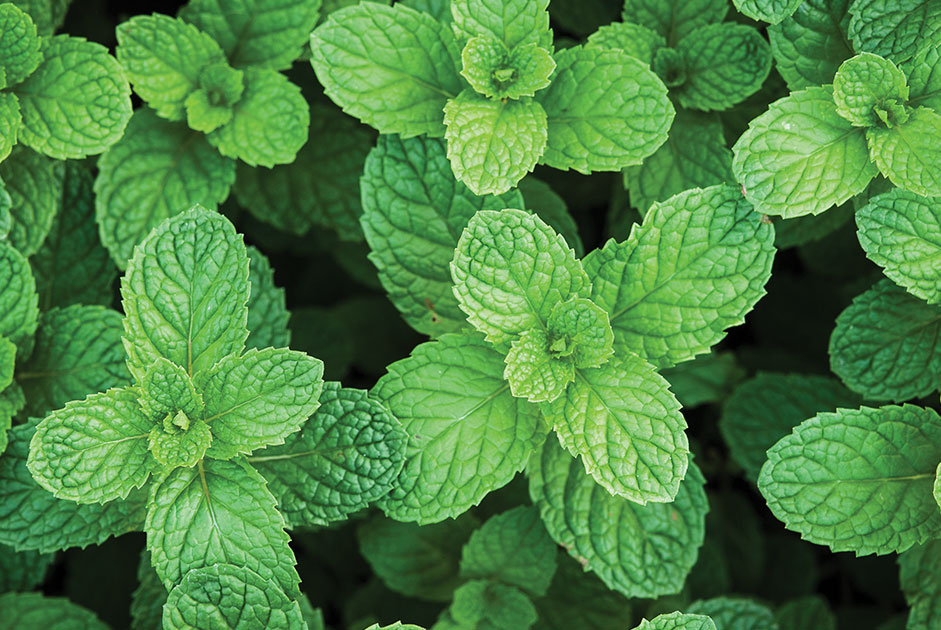The cultural knowledge of herbal lore is not entirely lost. The information may still be in our genes, urging to take root and blossom. It begins by loving the taste and fragrance of herbs. Take the interest one step further and start drying leaves and flowers to make delicious teas, healing salves, tinctures, poultices and more to promote wellness!
Along a pathway, the fragrance of mint arrives well before the sight of the tall green leaves. One deep inhalation leaves the body feeling energized. No wonder peppermint is “a blast of green energy” across the seasons. Due to the calcium, magnesium and potassium minerals, leaves whether sliced or infused add a refreshing flavor to salads and pesto, drinks and candies. And, when the body seeks relief to ease headaches, cramping, digestive difficulties, stings and toothaches, peppermint serves medicinal needs.
Growing Peppermint with Caution
A “stolon” is an above-ground root or horizontal stem extending from the parent plant. It is how mint expands from one plant to an increasingly expansive area. While the runners can consume a flowerbed, select an area for the invasive plant to go wild. It is both a repellant of stinkbugs and mice and an attractant of wasps; therefore, consider your location carefully!
Drying Leaves
Enjoying the fresh scent of basil, echinacea and peppermint does not have to end in autumn. Take time to collect the best quality leaves and consider drying by hanging or using a food dehydrator or oven. When leaves remain in a sealed, glass jar, the aroma may lessen; yet, the antioxidant, anti-inflammatory and antiviral properties remain. With a large jar of dried leaves, consider using, sparingly, for other practical medicinal purposes.
Cold Relief Tea
Similar to bulk, loose tea, dried mint requires crumpling either alone as a pure mint infusion or with other herbs such as thyme, chamomile or echinacea. All three offer wellness for sore throats and the onset of sickness.
Thyme and peppermint are especially ideal for persistent coughs, respectfully a natural expectorant and decongestant. Add a tablespoon of each herb to two cups of water. Just a teaspoon of honey helps soothe the throat, while a wedge of lemon also benefits congestion difficulties.
Mint Ice Cubes
In considering the anti-inflammatory properties of mint, drinking peppermint-infused water or making peppermint can reflect upon the beautification of skin and body. It’s understandable why grandmothers and mothers keep peppermint candies on hand. The medicinal value aids sluggishness, headache, digestive woes and improves skin. Add a few leaves to water or ice trays to receive the same benefit year round!
A Digestive Calming Tincture
Tinctures are an herbal preparation that goes beyond using water. While some herbalists prefer to use vinegar, rum or brandy, vodka is tasteless and odorless. Be sure to select a food grade, 80-proof alcohol. Allow joint pain or digestion difficulties to dictate the size of the container needed. Be patient! Tinctures take roughly six weeks until ready to use.
Recipe: Select a glass jar with a rubber gasket. (Metal will corrode.) Harvest the young, smaller leaves from the top of the plant, or use dried. Wash fresh leaves and dry thoroughly. For every ounce of plant matter, add five ounces of alcohol. Stir before filling to the top, eliminating space for air. Allow the jar to sit in darkness for six weeks, and shake daily. Strain, removing plant matter; then, transfer to another jar. Take one teaspoon up to three times per day to ease the ailment.
Peppermint Oil & Foot Scrub
Steam, by way of distilling, is one method to extract oil from a plant; another option is to infuse the leaves directly in olive or grapeseed oil. Rather than purchase a bottle, herbalists can make their own.
Plant matter, consumed or applied to the skin offers a medicinal benefit. The following recipe is a Peppermint Sugar Scrub to rejuvenate tired feet. Store in the refrigerator to extend its use beyond three months.
Recipe: Add one cup of sugar and a half cup of virgin coconut oil, softened. Stir; then pour the contents of one mint tea bag and add 10 drops of peppermint essential oil. Once well combined, it’s ready for use!
Become a Herbalist
The 12-month journey began with an understanding of herbs and their medicinal properties and benefits. Don’t end your curiosity. Continue! Go to your local library and start reading the wonderful books from master herbalists Rosemary Gladstar, Amy Jirsa and Colleen Codekas. You too can take your interest one step further by making herbal soaps, bulk teas and medicinal tinctures and salves.





















